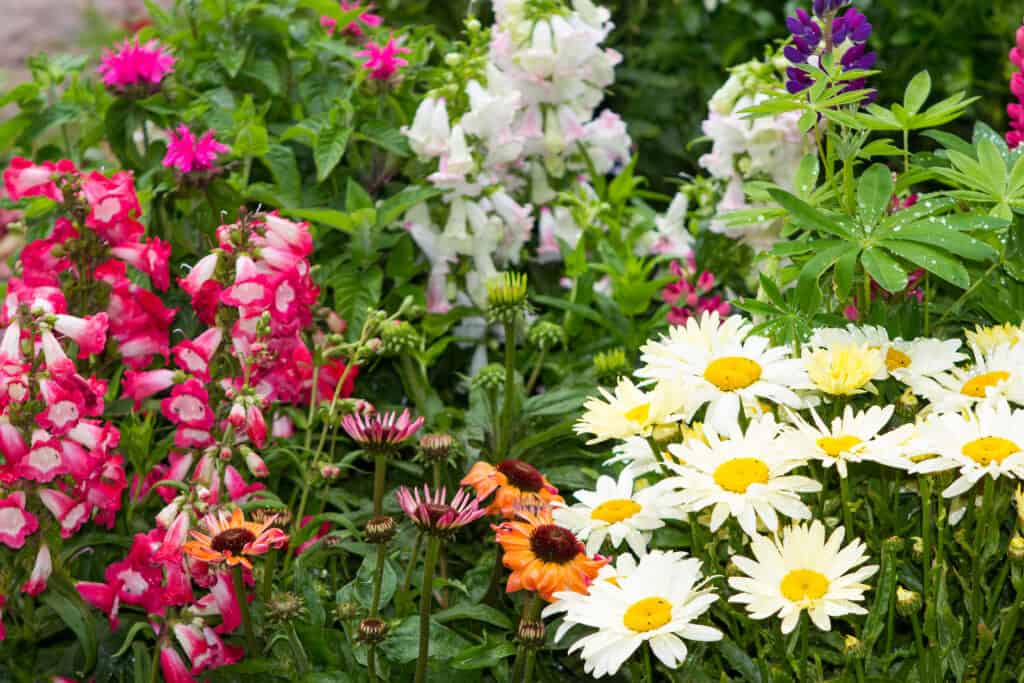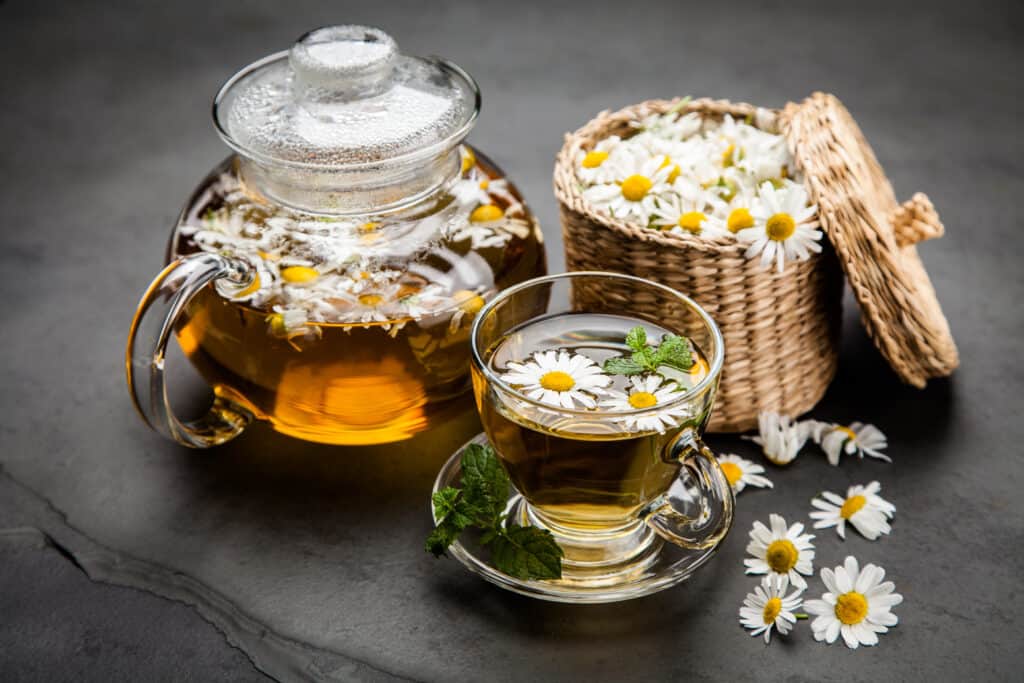Chamomile is perhaps best known for soothing teas and soaps that treat eczema, but did you know chamomile is a plant that looks just like a daisy? It’s very easy to confuse the two, so let’s take a closer look and discover how you can make your own tea and whether chamomile is perennial or annual.
Chamomile: Perennial or Annual?
It depends on what type of chamomile it is.
English chamomile is a hardy perennial with daisy-like flowers and fluffy leaves with that distinctive chamomile scent. However, there’s another type called German chamomile. Of the two, it’s English chamomile that’s perennial. German chamomile is annual.
Does Chamomile Come Back Each Year?
Perennial English chamomile comes back each year, but German chamomile doesn’t. German chamomile is a prolific seeder though, so you might find German chamomile popping up in the flower border after a long winter. It’s not the same plant, but brand-new annuals.
What Does Perennial Plant Mean?
A perennial plant is one that lives for more than two years. Even though some die back to a rootball to evade cold temperatures on their foliage, perennials will grow back the following spring. Some of them will re-grow to many feet in height each year! There are some perennials that remain evergreen too.
Annuals, on the other hand, complete their lifecycle in one year. They germinate, flower, seed, and die quickly, putting all their energy into seed production. Bedding plants like petunias and marigolds are usually annuals.
Before we move on, it’s worth mentioning the biennials. Biennials confuse lots of people! ‘Bi’ means two, but these plants don’t flower twice a year. Bi refers to their lifecycle. Biennials germinate in year one, then they rest over winter. The following spring they flower and set seeds before dying off. They have a two-year cycle. Chamomile is not a biennial. It’s a perennial or annual depending on its species.

English Chamomille is a perennial plant, meaning it blooms all year-round.
©Martina Osmy/Shutterstock.com
All About Chamomile
Chamomile is the catch-all name for several plants in the Asteraceae family. There are two main species as we’ve already discovered called Matricaria recutitia and Anthemis noblis. They are both members of the Asteraceae family but belong to different genera.
Anthemis noblis is the English chamomile, but it’s confusingly also called garden chamomile or Roman chamomile. It’s low-growing with hairy stems, scented feathery foliage, and white-yellow daisy-like flowers. It’s a perennial chamomile, not an annual, and hardy in US Zones 4-11. English chamomile is native to Europe and north Africa, but because the early settlers brought it across with them, it has naturalized in the USA.
English chamomile spreads around a foot across the soil via rhizomes, so it’s excellent ground cover as well as the type of chamomile you can make soothing tea from.
Matricaria chamomilla, the German chamomile (also called wild chamomile or Hungarian chamomile) looks very similar with lacy foliage and daisy-like flowers, but it’s taller and much more upright with smooth stems. It’ll reach 2-3 feet in height. This chamomile is not perennial like English chamomile. It’s an annual that’ll only live for one year.
German chamomile is hardy in US zones 4-9. Its seeds will lie dormant throughout winter, and sprout up when the warm weather returns.
This chamomile is native to the warmer regions of central and south Europe, but like perennial chamomile, it’s naturalized in the USA.
Both species of chamomile flower from June to October and love slightly acidic soil with plenty of sunshine.
Throughout history, chamomile has been used as a medicine. The ancient Egyptians, Romans and Greeks all used it to heal wounds, and relieve headaches and pain. Currently, chamomile is used as a relaxant and anxiety soother. This article from Molecular Medicine Reports investigates the uses of chamomile from ancient to modern times.
Is Chamomile Good For You?
Pregnant women should not use Roman chamomile because it may cause miscarriage. It also interferes with some medicines such as blood thinners and sedatives. If you have health issues or you’re pregnant or breastfeeding speak to your doctor before using chamomile.
However, chamomile contains lots of chemicals that are good for humans. There are no medical trials that prove it clinically treats anxiety or insomnia, but anecdotal reports and user experience indicates chamomile is a relaxing scent that soothes nerves, so the tests continue. Chamomile is currently being researched for its anti-oxidant and cancer-fighting properties.
Make Your Own Tea With Home-Grown Chamomile
A relaxing cup of chamomile tea is a soothing alternative to caffeine-fueled drinks and it may calm down nerves.
A chamomile infusion is simple to make. Just pour boiling water on picked flowers and let it steep for ten minutes. You can use perennial English chamomile or annual German chamomile for an infusion.
Traditionally it’s just the yellow centers that go in the tea, but the petals can be used too. In summer, collect flowers and dry them spread out on a kitchen towel ready for winter.

Chanomile is very popular for use in chamomile tea, which people commonly use to relax.
©George Dolgikh/Shutterstock.com
How To Grow Chamomile
Both species of chamomile enjoy the same growing conditions. Plant them in full sun or partial sun in well-drained soil. Chamomile doesn’t like soggy roots! They are drought tolerant and able to cope for long periods of time without water, but in dry spells a drink will encourage more flowers.
Annual German chamomile is easy to grow from seed. If you’re not particularly tidy around the garden, you’re likely to find seedlings dotted about as it re-seeds very easily. Dig them up and replant them in a well-drained sunny spot.
If you don’t have any, don’t worry! Just buy a packet of inexpensive seeds and sprinkle them thinly on damp compost in early spring. Don’t cover them with soil because they need light to germinate. Just keep the compost slightly damp and they will germinate in a few weeks.
How To Harvest Chamomile For Tea
Harvesting flowers for chamomile tea is very easy. Gently pinch off the flowerhead just below the biggest part. They’re ready to pick when the flowers are fully open, and its best to give them rinse to wash away any insects.
Bees love chamomile, so do consider leaving some blooms for our essential pollinating friends!
Is Chamomile Toxic For Dogs?
Yes, chamomile is toxic for dogs, cats, and horses according to the ASPCA, but they would have to eat a lot to develop symptoms such as diarrhea, vomiting, and bleeding.
Food supplements and herbal medicines containing chamomile are offered on the market for pets, so it’s best to stick with those recommended by your vet because they have the safe amount added, rather than adding chamomile to food or allowing pets to chew on the plant.
Will Chamomile Plants Spread?
Yes, chamomile will spread. English Chamomile will spread to about a foot in all directions if it’s not cut back and annual German chamomile spreads its seeds all around the garden as it pleases!
How To Cut Back Chamomile In Winter
Perennial garden chamomile is hardy enough to make it through winters in USA zones 4-11 without assistance, but they can start to look ragged and frost can blacken some of its foliage. It’s best to trim chamomile plants back to a neat clump as winter approaches and growth has finished for the year. Make sure they have plenty of drainage. Chamomile can survive the cold, but not wet rotting roots.
Telling Camomile and Daisies Apart
Chamomile is a daisy-like plant, so it’s pretty hard to tell the difference between it and feverfew or ox-eye daisies unless you’re an expert!
The main way is the scent. Does it smell like chamomile? Then it probably is!
In general, perennial English chamomile is low growing. It has lacy foliage and white flowers with raised yellow cones in the center. German chamomile is much taller at 2-3 feet, but it also has those raised center cones.
Feverfew is the trickiest to tell apart from chamomile. Feverfew is scented too and it has bright lime green leaves, but the yellow center is a flat disk.
Garden Chamomile Is Perennial, Not Annual!
So, that’s all about chamomile! It’s an enchanting plant that attracts pollinators and creates delicious soothing tea but remember it’s Anthemis noblis the English chamomile that’s perennial. Matricaria recutitia the German chamomile is annual.
Luckily for us, we can drink both!
Up Next
The photo featured at the top of this post is © Olesya Myzzz/Shutterstock.com
Sources
- , Available here: https://medlineplus.gov/druginfo/natural/752.html
- , Available here: https://www.rhs.org.uk/herbs/chamomile/grow-your-own
- , Available here: https://www.rhs.org.uk/lawns/chamomile-lawns
- , Available here: https://www.rhs.org.uk/plants/17986/tanacetum-parthenium/details
- (1970)
Thank you for reading! Have some feedback for us? Contact the AZ Animals editorial team.






